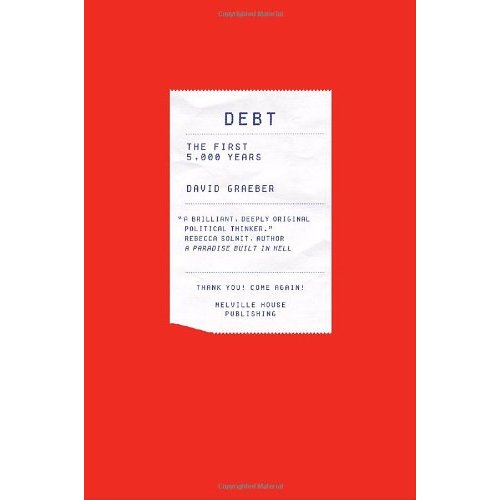Anthropologist David Graeber is brilliant & I must have bought at least a dozen copies of this book for friends and family.
Normally when I read a book I generally try to share all the highlights I made in it, however I highlighted so much of this book that it is hard to even share a small fraction of it. The book is about the history of money & debt. It largely has the goal of debunking modern economic ideology & thought by showing how flawed, dishonest & incorrect much of our economic beliefs are & how diverse our history has been…with the hopes of making our minds open to a broader array of opportunities in the face of current economic crisis.
While this is one of my favorite books I have ever read & I can’t share all the stuff that I thought was great from it, here are a few bits (at least as I understood them)…
- Debt is treated differently depending who is in debt. if a more powerful person is in debt, then the debt can basically be erased at will. whereas a weaker person/entity/country is typically forced to “pay their debts”
- Debt has been around for 5,000+ years & has spent a large period of that time in virtual form. virtual credit was largely based on the trustworthiness of the lender & thus largely local in nature. debt was largely associated with the social fabric of local communities.
- barter leading to markets & money is a myth. people did shared favors back and forth & did to some degree keep track of what they owed, but debts were tied to social relationships & there was a large baseline sense of reciprocity. markets are largely created (& maintained) by states or similar sources of power & they are typically created in order to fund military conquest. most state debts are military driven, and many of the earliest uses of cash payment were largely for those tied with governmental payments of tax & foreigners who were not well known and trusted within the community.
- coins made it easy to take (eg: theft, plunder, spoils of war, taxes, etc.) stored wealth from one location & spend it in another. it also made it easier to collect taxes & force the acceptance of military pay through the economy in order to pay said taxes. that in turn made it easier to send larger armies longer distances, since they can feed off both plunder AND the lightweight & densely valued coins. that in turn created more conquered person turned slaves (who “owed” their saved lives) to be spent in silver mines to create more coins.
- our current version of free market capitalism was largely built on war, violence, debt peonage & slavery.
- state vs free market ideology is largely a myth, as impersonal systems of debt are largely reliant on the state for enforcement. early versions of city-states built credit laws around mitigating/ameliorating the socially destructive impacts of debt (limiting the impact of usury, and rather than allowing debt-driven slavery or near slavery to rip families & the cities apart, at some point kings would conduct debt jubilees to clear the debt).
- many religions for at least some period of time outlawed usury (Buddhism was one of the few exceptions here, but that was because they lent the money out from the monasteries to fund the creation of more monasteries & statues and such, in an attempt to fund the further spread of Buddhism).
- in many cases outside of Buddhism charging interest only came to be seen as acceptable on commercial loans, and first as a fine for late payments & then it was seen as loss to a person from not being able to have that money invested in productive enterprises. Islam originally forbid interest because there was a belief that returns should only be commensurate with the work and risk you take & as soon as you have a fixed rate of return guaranteed that breeds sloth & there is no risk being taken In many religions charging interest was only seen as fine if it was done on other people.
- throughout history many lenders would eventually become slaughtered once they put too much strain on kings & their kingdoms. this only changed when bankers bought & controlled the system of governance, such that rather than worrying about the risk of skimming too much rent seeking off society, they could pass laws to enforce contracts & make punishments stiff for those who did not pay them.
- romanticized images of medieval knights were largely made to mirror how the merchant classes viewed themselves. knights originally tended to run in pacts more like gangs and act without any sense of chivalry, which is why games were created, to get them to compete with one another and occupy their time and attention
- after the bubonic plague killed about 1/3 of the people across Europe laborers got a larger share of profits & that in turn required new laws to be created to make it easier to separate rich from poor. the thriving middle class was then impoverished through a century of inflation tied to money creation by the bankster class. taxes had to be paid in hard money (eg: silver) yet coinage was scarce during this time period. how can you have inflation & scarce money at the same time? it was the combination of military finance, bank leveraging metals over and over again to create significantly greater currency & the requirement to pay taxes in a different form than everyday transactions occurred in (allowing the paper currency & thus value of labor to be depreciated against the value of metals).
- some of the most savage human behavior (eg: the Spanish Conquistadors ) is tied to people who were in debt that they felt was unjust & were willing to do whatever it took to get out of debt. when the booty was split up & there wasn’t enough to cover their debts it became more reasonable to slaughter off the natives by working them to death in the mines. while some of these sorts of behaviors are marketed as being a historical aberration, this sort of behavior was going on into the 1900s with the Huitoto Indians in Peru. When those Indians refused to take on loans to become debt peons they were forced to take them at gunpoint, so that it could be then justified to work them to death.
- what is awkward with our current financial set up is that rather than protecting borrowers from lenders, our current system is built around protecting lenders from borrowers.
- the mix of debt and morality is a blurry path where religious ideals get mixed in with an interpretation opposite of their original. originally some beliefs were that our debts to the cosmos & parents were immeasurable, but that was later spun to be suggested that indeed our value as people could (& should) be measured. typically this became accepted by measuring clear outsiders who are ripped from their social fabric (like slaves), but where that became a norm it was then a standard of measurement against which other fines could be based on.
- while much is stated of slaves from Africa, the same sort of slavery was around in Roman times & far more recently there was also similar “people as money” in other areas, like Ireland. today there are more slaves alive than at any point in history.
- our version of capitalism is as much a system of exclusion as inclusion. for some people to get significant perks someone somewhere else must be getting hosed. for example, Haiti passed a law to increase minimum wage. However the US government intervened & had it overturned on behalf of Warren Buffet’s Berkshire Hathaway, which owns Fruit of the Loom. (this last part wasn’t cited in the book as a specific example, but is a recent example of the sort of behavior)
This review on Amazon.com is quite good.


This was a great quote from the book David shared on a review someone else did where they intentionally mis-represented his book & he corrected them…